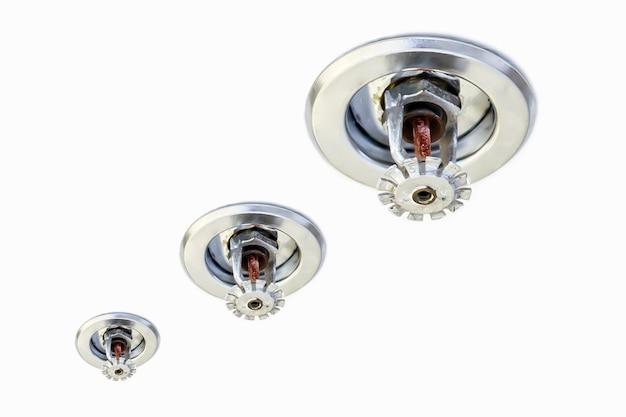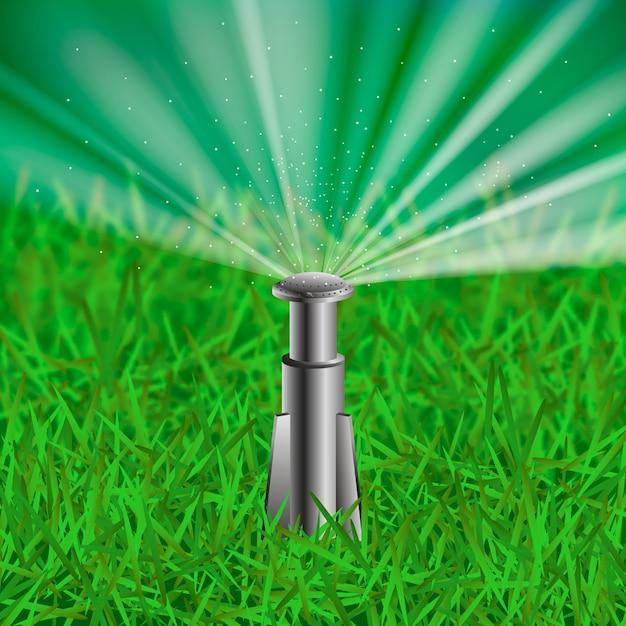Sprinkler systems are a convenient and efficient way to keep your lawn and garden looking lush and healthy. But how many heads are on a sprinkler zone? This is a common question among homeowners who are planning to install or upgrade their irrigation systems.
In this blog post, we’ll delve deeper into the world of sprinkler systems and help you understand the factors that determine the number of heads you need for each zone. We’ll discuss the minimum distance between sprinkler heads, the number of heads per zone, and how to calculate the ideal number based on your specific requirements. Additionally, we’ll explore common issues such as low pressure and incomplete head-popping, and offer solutions to improve the performance of your system.
So, whether you’re a newbie to sprinkler systems or a seasoned pro looking for expert advice, keep reading to find answers to all your burning questions about sprinkler heads, zones, and more!

How many sprinkler heads are typically found in a zone?
If you’ve ever wondered how many heads are on a sprinkler zone, you’re not alone. It’s a common question for homeowners and garden enthusiasts alike. So, let’s dive into the world of sprinkler systems and demystify the number of heads you can expect to find in a typical zone.
The magical number of heads in a sprinkler zone
To put it simply, there isn’t a magical number that fits all sprinkler zones. The number of heads in a zone depends on various factors like water pressure, the size of the area being irrigated, and the type of sprinkler heads being used.
Meeting the needs of your landscape
When determining how many sprinkler heads to include in a zone, it’s important to consider the unique needs of your landscape. For example, if you have a small yard, you may only need a few heads to adequately water the area. However, if you have a larger garden or lawn, more heads will be necessary to ensure even coverage.
Water pressure: the unsung hero
Water pressure plays a crucial role in determining the number of heads in a sprinkler zone. If you have low water pressure, you’ll need fewer heads to maintain adequate water flow. On the other hand, if you have high water pressure, you can accommodate more heads in a zone without compromising the performance of your sprinkler system. So, it’s essential to test your water pressure and adjust the number of heads accordingly.
The art of sprinkler head spacing
Now, let’s talk about the art of sprinkler head spacing. It’s not just about the number of heads; it’s also about how they are spaced. When planning your sprinkler system, you’ll want to ensure that the heads overlap slightly to avoid dry spots. This means you may need to adjust the number of heads to achieve proper coverage and prevent any thirsty patches in your garden.
Choosing the right sprinkler heads
There are different types of sprinkler heads available, each with its own coverage area. For example, rotor heads can cover a larger radius, while spray heads are better suited for smaller, more precise areas. By selecting the right type of sprinkler heads for your landscape, you can ensure efficient watering and maximize the number of heads in your zone.
Calling in the professionals
If all this talk of water pressure, head spacing, and types of sprinkler heads has your head spinning, don’t worry! Consulting with a sprinkler system professional can take the guesswork out of determining the number of heads in your zone. They have the knowledge and expertise to design a system that meets the specific needs of your landscape while taking into account all the necessary factors.
Wrapping it up
So, the next time someone asks you how many heads are on a sprinkler zone, remember that there isn’t a one-size-fits-all answer. It depends on the size of your yard, water pressure, and sprinkler head spacing. And if you need expert advice, don’t hesitate to reach out to a professional. Remember, a well-designed sprinkler system can keep your landscape lush and green, saving you time and effort in the long run. Happy watering!

FAQ: How Many Heads Are on a Sprinkler Zone?
Are you wondering about the number of sprinkler heads on a sprinkler zone? Look no further! In this comprehensive FAQ-style guide, we’ll answer your burning questions with a sprinkle of humor along the way.
How many sprinkler heads are in a head box
A head box traditionally houses multiple sprinkler heads, typically ranging from 2 to 4 heads. However, the number of heads can vary depending on the specific system and the area it needs to cover.
What is the minimum distance between sprinkler heads
To ensure efficient water distribution, sprinkler heads should be placed with a recommended minimum distance of 10 to 15 feet apart. This spacing allows for adequate coverage without creating wet or dry spots in your lawn or garden.
Can one sprinkler valve control two zones
Unfortunately, even the most talented sprinkler valves need a little alone time. Each zone typically requires its own valve to regulate water flow effectively. So, give your sprinkler valves some space and let them work their magic individually.
Why aren’t my sprinklers getting enough pressure
Low-pressure sprinklers? That’s a soggy situation! Several factors could be at play here, including a clogged nozzle, insufficient water supply, or even a misaligned valve. It’s time to do some detective work to identify the root cause and restore the much-needed pressure.
How many sprinkler heads per zone do you need
Ah, the age-old headcount question! The answer depends on various factors such as water pressure, pipe size, and the type of heads you’re using. As a general rule of (green) thumb, you can typically connect 3 to 5 sprinkler heads per zone, ensuring proper water distribution.
How do you do multiple sprinklers
Oh, we love a good multitasker! To accommodate multiple sprinklers, you can create different zones, each with their own set of sprinkler heads. This way, you can give each area the attention it deserves while keeping your lawn refreshed and envy-worthy.
How deep do sprinkler pipes need to be
Digging deep, aren’t we? Sprinkler pipes are usually buried around 8 to 12 inches deep to protect them from accidental damage and harsh weather conditions. Just remember, while the pipes may be underground, your sprinkler dreams will be soaring high!
How do I increase water pressure in my sprinkler system
Is your sprinkler system feeling a bit lackluster? Boosting water pressure can be achieved by installing a pressure-boosting pump, checking for any leaks or blockages, or ensuring your main water line is fully open. Time to turn up the pressure and let your sprinklers shine!
Can I use PEX for a sprinkler system
PEX and sprinklers might sound like a potential match made in irrigation heaven, but it’s best to stick to conventional PVC or polyethylene pipes. PEX pipes are primarily designed for indoor use and may not withstand the harsh outdoor elements or the water pressure demands of a sprinkler system.
What is the best pipe size for a sprinkler system
Pipe size matters, my friend! For most residential sprinkler systems, a pipe with a diameter of 1 inch should suffice. However, larger properties or systems with high water demands may require pipes with a diameter of 1.5 or even 2 inches. Go big or go dry!
How much does it cost to add a sprinkler head
Ready to splash some cash for an additional sprinkler head? The cost can vary depending on factors such as location, existing system complexity, and the head’s quality. On average, you can expect to shell out around $50 to $100 per head, including installation. Good things come at a cost, but a lush lawn might just be worth it!
How many valves does a sprinkler system have
Valves, valves everywhere! A typical sprinkler system has multiple valves, one for each zone. So, grab your notepad and start counting those zones to determine how many valves you’ll need. It’s time to embrace your inner valve aficionado!
How do you calculate the number of sprinkler heads per zone
Get your math hats on! To calculate the number of sprinkler heads per zone, divide the zone’s total square footage by the coverage area of each sprinkler head. Don’t forget to take into account your desired sprinkler head spacing for optimal water distribution. Get those calculations right, and your lawn will thank you!
How many sprinklers can I run at once
Let’s talk about multitasking in the sprinkler world! The number of sprinklers you can run simultaneously depends on your water supply and water pressure. However, as a general rule, you want to avoid overloading your system and compromising water distribution. So, take it slow and let your sprinklers sparkle one at a time.
How many sprinkler heads do I need
Ah, the eternal question! The number of sprinkler heads you need largely depends on the area you want to cover. Each sprinkler head can typically cover around 20 to 25 feet, so divide your total area by this value to find out how many heads will keep your lawn green and your flowers happy.
How many square feet does a sprinkler head cover
The coverage area of a sprinkler head can vary depending on the head’s type and design. On average, a sprinkler head can cover anywhere from 20 to 25 square feet. With their watery dance moves, they ensure your lawn gets the right amount of hydration, one square foot at a time.
How do sprinkler zones work
Welcome to the world of sprinkler zones, where every area gets its own special treatment! Sprinkler zones divide your landscape into separate areas, each with its dedicated set of sprinkler heads. This division ensures efficient water distribution, allowing you to customize watering based on your plants’ needs. It’s like a personalized spa day for your garden!
How long can a sprinkler line be
We measure lines in feet, not furlongs! While sprinkler lines can extend to great lengths, it’s important to maintain water pressure and proper coverage. As a rough guideline, aim to keep your sprinkler lines under 200 feet long. Anything longer, and poor water pressure may rain on your parade.
Is there a valve for every sprinkler zone
Valves are like the superhero guardians of sprinkler zones! Each sprinkler zone typically has its very own valve, regulating water flow and ensuring an even distribution of liquid love. So yes, every zone gets its valve, ensuring a fair share of attention to every corner of your green paradise.
What causes sprinkler heads to not pop up all the way
Oh, those shy sprinkler heads! Common culprits for incomplete pops include dirt, debris, or good old-fashioned wear and tear. Give your heads a little TLC by cleaning or replacing them as needed, and soon they’ll be resurfacing with pride, ready to shower your lawn with water in all their full-height glory.
How do you set up an irrigation zone
It’s time to embrace your inner captain and take charge of your irrigation ship! Setting up an irrigation zone involves dividing your landscape into sections based on similar watering needs, installing the necessary pipes, valves, and sprinkler heads, and configuring each zone to receive the right amount of water. Navigate those waters, and your lawn will flourish like never before!
Why does one of my sprinkler zones have no pressure
Oh no, a pressure-free zone? The culprit for this soggy conundrum can be a closed or malfunctioning valve, a pipe blockage, or even a faulty solenoid. Investigate these potential issues, and you’ll get that water flowing through your sprinkler zone once again!
And there you have it—FAQ-style sprinkler head wisdom wrapped in a sprinkling of humor! We hope this guide quenched your thirst for sprinkler knowledge and left you feeling empowered to conquer your own piece of landscaped heaven. Happy watering and may your lawn always be the envy of the neighborhood!